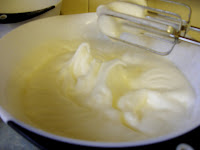So, last night was the return of the Great British Bake Off, only possibly the most exciting thing to happen in my life in the month of August. And let me tell you, it was a cracker. This show always gets me motivated to spend more time in the kitchen, it also seems to have a significant impact on our waistlines. but who can resist Mary Berry and an hour of cakes, breads and other glutinous goodies once a week? I, for one, cannot.
 |
| Mary Berry, baking legend. |
 |
| Soft peaks, in case you wondered. |
Angel Food Cake
10 Egg whites
1 tsp. cream of tartar
1 tsp. vanilla extract
1/2 tsp. almond extract
250 g (9 oz) caster sugar
 |
| Folding in the flour. |
125g (4 1/2 oz) plain white flour (sifted)
1. Preheat the over to 180 C (350 F). Whisk the egg whites in a large bowl until they become foamy. Sprinkle in the cream of tartar and the vanilla and almond extracts. Continue whisking until the mixture forms soft peaks.
2. Add the sugar, one tablespoon at a time, whisking continuously. When all the sugar is added the mixture should be shiny and form soft peaks.
3. Fold the flour in with a metal spoon or spatula, blending it thoroughly without breaking down the egg whites. I alternated between sifting in about half a cup of flour and folding, so that the flour didn't form lumps.
4. Spoon the mixture into an UNGREASED ring shaped (bundt) cake tin. Cut a cake knife or spatula trough the mix to let out and large air pockets and smooth the top.
5. Bake on the lowest shelf in the oven for 45 minutes or until the cake has risen, browned and cracked on top and is dry (if a toothpick inserted into the middle comes out clean, it's done).
6. Leave the cake to cool UPSIDE DOWN for at least an hour and a half, this ensures that it doesn't collapse on itself while cooling.
6. Leave the cake to cool UPSIDE DOWN for at least an hour and a half, this ensures that it doesn't collapse on itself while cooling.
 |
| Cooling upside down. |
7. Use a cake knife, knife or spatula around the edges to remove the cooled cake from the tin. Cut into slices with a bread knife (or any knife, serrated is just easiest) and serve with whatever you fancy. I like fresh berries and whipped cream, but Mary used lemon curd, and other members of my family like chocolate sauce or ice cream. Really it goes well with anything.
I had a couple issues with this cake, mainly to do with my egg whites. I used a hand-help electric mixer, and I think I may have over whisked my egg whites while I was adding the sugar, because they had been stiff enough to form soft peaks, but they loosened up again by the time the sugar was in. Next time I'll use a lower speed setting on the mixer. Also, I didn't have any vanilla or almond extract around the house (and they're expensive to buy) but I did have some vanilla paste, so I subbed in 1/4 tsp. vanilla paste for the extract and left out the almond altogether. Now, I haven't cut into it yet (although I really really want to), but it rose fine in the oven, didn't collapse on me while cooling, and now I have it out of the tin it looks like it has baked really nice and evenly. So all in all I'm really happy with the result and will definitely be baking this one again!
Sally, I hope you enjoy this one, it's completely fat free and there's not really that much sugar in it either, if you keep off the cream and just have it with some fresh berries (maybe do a quick compote with them) it's fairly diet friendly.
I had a couple issues with this cake, mainly to do with my egg whites. I used a hand-help electric mixer, and I think I may have over whisked my egg whites while I was adding the sugar, because they had been stiff enough to form soft peaks, but they loosened up again by the time the sugar was in. Next time I'll use a lower speed setting on the mixer. Also, I didn't have any vanilla or almond extract around the house (and they're expensive to buy) but I did have some vanilla paste, so I subbed in 1/4 tsp. vanilla paste for the extract and left out the almond altogether. Now, I haven't cut into it yet (although I really really want to), but it rose fine in the oven, didn't collapse on me while cooling, and now I have it out of the tin it looks like it has baked really nice and evenly. So all in all I'm really happy with the result and will definitely be baking this one again!
 |
| Looks pretty angelic to me! |















